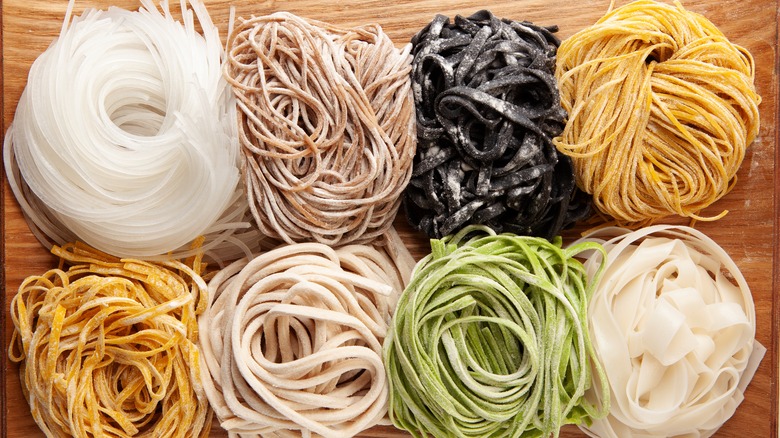There’s something fresh soba noodles appetizing about their long, dangly shape and ability to pair with countless sauces, soups, and assorted ingredients. We’re talking about noodles of course!
If you’re used to considering noodles as one single mono-category, prepare to be astonished by the vast choices available. Different compositions, shapes, lengths, and textures make each type of noodle unique and best suited for a handful of purposes. It’s easy to pick up a package of dry noodles and call it dinner, but the craft of noodle-pulling is steeped in tradition and worth discovering. The range of techniques and styles encompassed in the vast array of noodle dishes is seemingly infinite, and you could do worse than trying to eat your way through this list. If you love your food long, slippery, and capable of being swirled, then you had better stock up on the many variations of this delicious food. Fairly popular in the take-out game, lo mein, meaning stirred noodles, is a popular noodle dish from China’s Guangdong province, according to Taste Atlas.
Noodles are first boiled, then mixed in with sauce and other ingredients. You’ll find add-ins such as cabbage, carrots, mushrooms, meat, and seafood. First introduced by immigrants in the 1850s, it’s been a popular dish in Chinese restaurants in the U. Some are rounded into a thin, tubular shape whereas others lie flat. But they weren’t always made this way.

LA-based chef Yoko Isassim, who was born in Seki, Japan, tells the outlet that, traditionally, women would knead it with their feet so that they could make use of their body weight to facilitate the task. They would often take it one step further and wear heavy backpacks to add more weight. Compared with soba noodles, which are also common in Japan, Japan-Guide. Udon can be served both hot and cold, which makes them common in dozens of preparations. Since the ingredients to make soba are so simple, it comes down to their quality. It follows that the noodles hold an important place spiritually and are perceived to be balanced and nutritious.
Much like udon noodles, soba is commonly served in both hot and cold preparations. Inaoka describes a typical recipe in Kyoto — seiro — which combines cold soba with wasabi, green onions, and a dashi soy sauce. If you’re eating the soba cold, be sure to save the cooking water as a nutritious broth to sip on. Meanwhile, the noodles can be enjoyed kake style in a hot broth.
Mei fun refers to both rice vermicelli noodles and dishes that showcase the thin strands. Mei fun is typical in cuisines across Asia, though its roots can be traced back to China a mere 2,000 years ago. The vermicelli is sold dry in nest-like bundles, which simply need to be rehydrated in hot water before they can be incorporated into recipes, according to The Spruce Eats. Because they are so delicate, as they absorb water they soften and develop the perfect amount of chewiness to complement various dishes. The thin noodles are definitely versatile, and you can add them to stir fries, soups, or even served chilled as a salad. According to The Spruce Eats, among the many preparations, Singapore mei fun, which doesn’t come from Singapore but from Cantonese cuisine, is a popular option.
Rice vermicelli is tossed with curry powder, shrimp, pork, egg, and mixed vegetables, resulting in bright yellow noodles with colorful add-ins. Whereas rice vermicelli are thin, delicate strands, flat rice noodles are wider and, per their name, flat. If you’ve ever enjoyed pad thai, then you’ve devoured flat rice noodles in the process. Once they’re boiled, you can toss them in a stir fry at the last minute, add them to soup, or serve them chilled for a filling salad. That’s right — munch on a bowl of these and you may as well be drinking from the elixir of life. Yi mein are light golden in color and owe their pleasantly chewy texture to soda water in the dough, as well as being fried before they are dried, per Gourmetpedia. Whether you’re eating the springy noodles with the hope of living forever or simply because you can’t get enough, yi mein is always a great choice.
